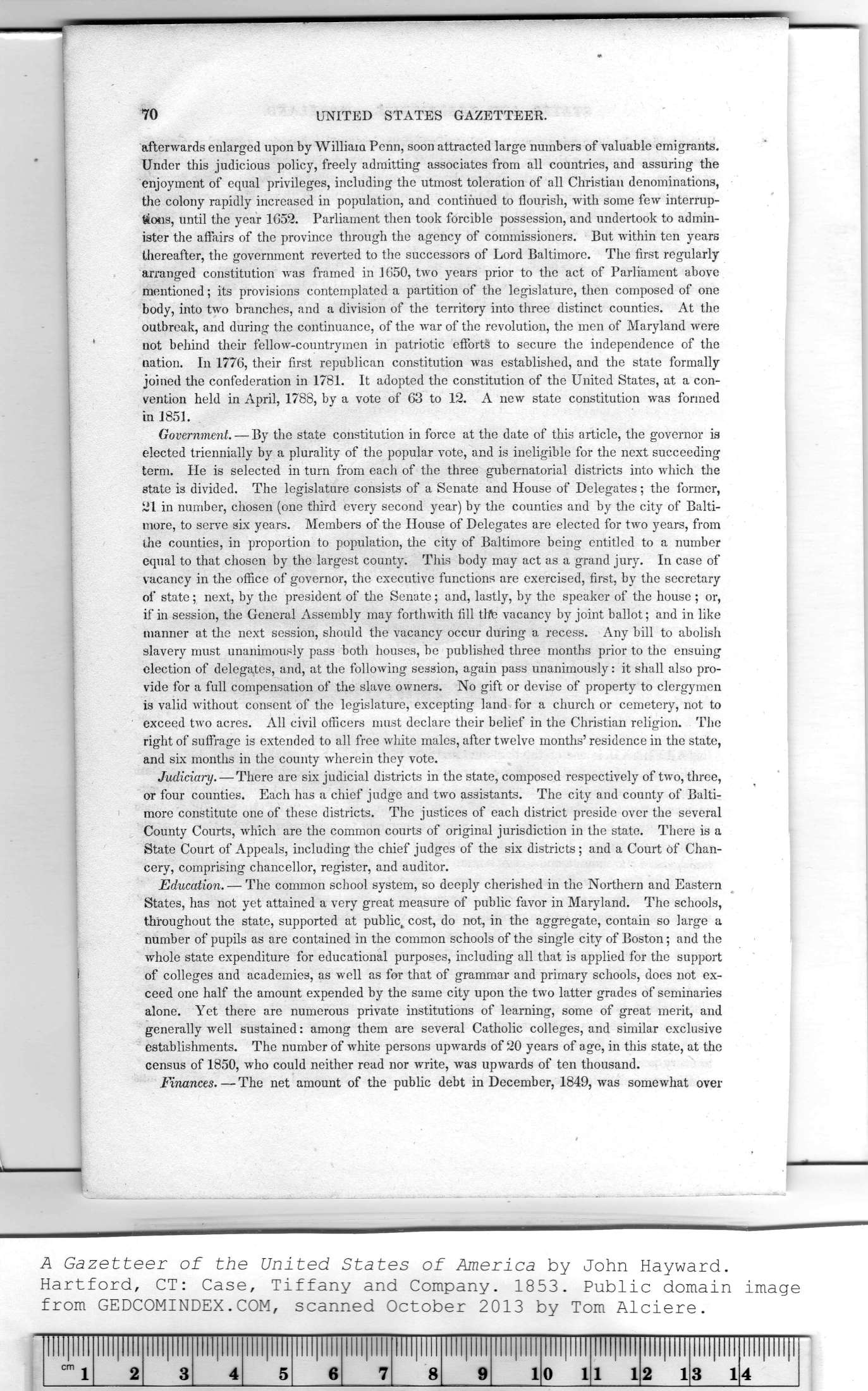|
|
Note: Ctrl and + increases the font size of the text below, Ctrl and - decreases it, and Ctrl and 0 resets it to default size.
70 UNITED STATES GAZETTEER.
afterwards enlarged upon by William Penn, soon attracted large numbers of valuable emigrants.
Under this judicious policy, freely admitting associates from all countries, and assuring the
enjoyment of equal privileges, including the utmost toleration of all Christian denominations,
the colony rapidly increased in population, and continued to flourish, with some few interrup-
tions, until the year 1652. Parliament then took forcible possession, and undertook to admin-
ister the affairs of the province through the agency of commissioners. But within ten years
thereafter, the government reverted to the successors of Lord Baltimore. The first regularly
arranged constitution was framed in 1650, two years prior to the act of Parliament above
mentioned; its provisions contemplated a partition of the legislature, then composed of one
body, into two branches, and a division of the territory into three distinct counties. At the
outbreak, and during the continuance, of the war of the revolution, the men of Maryland were
* not behind their fellow-countrymen in patriotic efforts to secure the independence of the
nation. In 1776, their first republican constitution was established, and the state formally
joined the confederation in 1781. It adopted the constitution of the United States, at a con-
vention held in April, 1788, by a vote of 63 to 12. A new state constitution was formed
in 1851.
Government. — By the state constitution in force at the date of this article, the governor is
elected triennially by a plurality of the popular vote, and is ineligible for the next succeeding
term. He is selected in turn from each of the three gubernatorial districts into which the
state is divided. The legislature consists of a Senate and House of Delegates; the former,
21 in number, chosen (one third every second year) by the counties and by the city of Balti-
more, to serve six years. Members of the House of Delegates are elected for two years, from
the counties, in proportion to population, the city of Baltimore being entitled to a number
equal to that chosen by the largest county. This body may act as a grand jury. In case of
vacancy in the office of governor, the executive functions are exercised, first, by the secretary
of state; next, by the president of the Senate; and, lastly, by the speaker of the house ; or,
if in session, the General Assembly may forthwith fill tlfe vacancy by joint ballot; and in like
manner at the next session, should the vacancy occur during a recess. Any bill to abolish
slavery must unanimously pass both houses, be published three months prior to the ensuing
election of delegates, and, at the following session, again pass unanimously: it shall also pro-
vide for a full compensation of the slave owners. No gift or devise of property to clergymen
is valid without consent of the legislature, excepting land for a church or cemetery, not to
exceed two acres. All civil officers must declare their belief in the Christian religion. The
right of suffrage is extended to all free white males, after twelve months' residence in the state,
and six months in the county wherein they vote.
Judiciary. — There are six judicial districts in the state, composed respectively of two, three,
or four counties. Each has a chief judge and two assistants. The city and county of Balti-
more constitute one of these districts. The justices of each district preside over the several
County Courts, which are the common courts of original jurisdiction in the state. There is a
State Court of Appeals, including the chief judges of the six districts ; and a Court of Chan-
cery, comprising chancellor, register, and auditor.
Education. — The common school system, so deeply cherished in the Northern and Eastern
States, has not yet attained a very great measure of public favor in Maryland. The schools,
throughout the state, supported at public^ cost, do not, in the aggregate, contain so large a
number of pupils as are contained in the common schools of the single city of Boston; and the
whole state expenditure for educational purposes, including all that is applied for the support
( of colleges and academies, as well as for that of grammar and primary schools, does not ex-
ceed one half the amount expended by the same city upon the two latter grades of seminaries
alone. Yet there are numerous private institutions of learning, some of great merit, and
generally well sustained: among them are several Catholic colleges, and similar exclusive
establishments. The number of white persons upwards of 20 years of age, in this state, at the
census of 1850, who could neither read nor write, was upwards of ten thousand.
Finances.—The net amount of the public debt in December, 1849, was somewhat over
A Gazetteer of the United States of America by John Hayward.
Hartford, CT: Case, Tiffany and Company. 1853. Public domain
|
